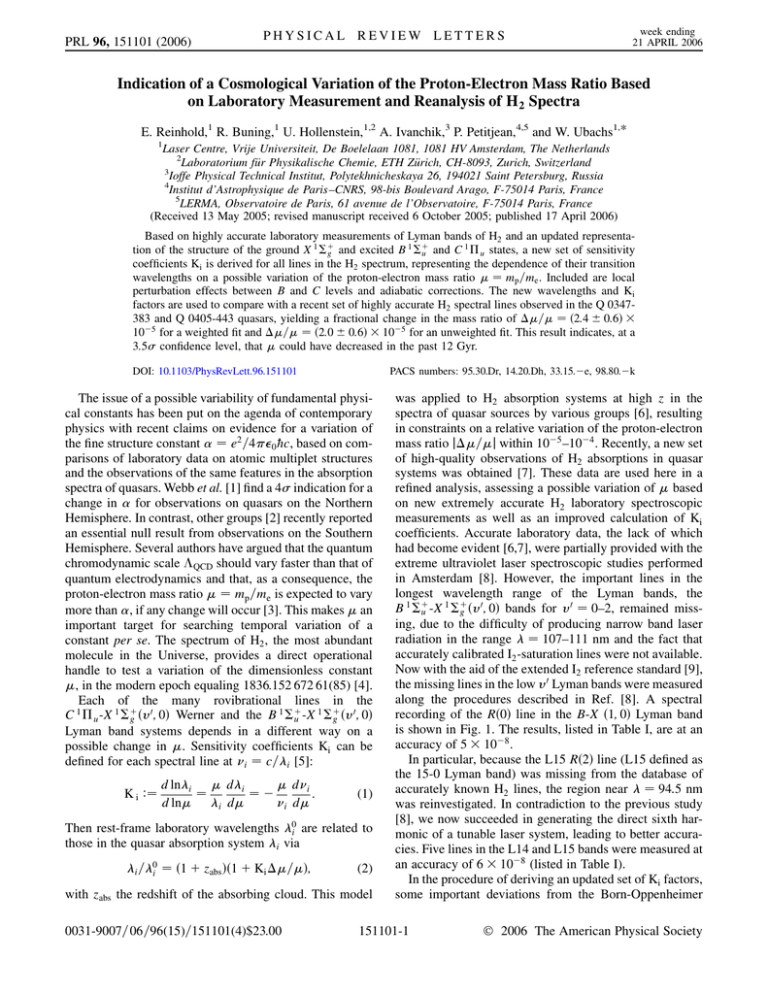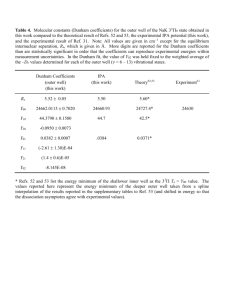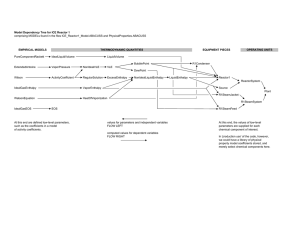Indication of a Cosmological Variation of the Proton-Electron Mass Ratio... on Laboratory Measurement and Reanalysis of H
advertisement

PRL 96, 151101 (2006) PHYSICAL REVIEW LETTERS week ending 21 APRIL 2006 Indication of a Cosmological Variation of the Proton-Electron Mass Ratio Based on Laboratory Measurement and Reanalysis of H2 Spectra E. Reinhold,1 R. Buning,1 U. Hollenstein,1,2 A. Ivanchik,3 P. Petitjean,4,5 and W. Ubachs1,* 1 Laser Centre, Vrije Universiteit, De Boelelaan 1081, 1081 HV Amsterdam, The Netherlands 2 Laboratorium für Physikalische Chemie, ETH Zürich, CH-8093, Zurich, Switzerland 3 Ioffe Physical Technical Institut, Polytekhnicheskaya 26, 194021 Saint Petersburg, Russia 4 Institut d’Astrophysique de Paris–CNRS, 98-bis Boulevard Arago, F-75014 Paris, France 5 LERMA, Observatoire de Paris, 61 avenue de l’Observatoire, F-75014 Paris, France (Received 13 May 2005; revised manuscript received 6 October 2005; published 17 April 2006) Based on highly accurate laboratory measurements of Lyman bands of H2 and an updated representa1 1 tion of the structure of the ground X 1 g and excited B u and C u states, a new set of sensitivity coefficients Ki is derived for all lines in the H2 spectrum, representing the dependence of their transition wavelengths on a possible variation of the proton-electron mass ratio mp =me . Included are local perturbation effects between B and C levels and adiabatic corrections. The new wavelengths and Ki factors are used to compare with a recent set of highly accurate H2 spectral lines observed in the Q 0347383 and Q 0405-443 quasars, yielding a fractional change in the mass ratio of = 2:4 0:6 105 for a weighted fit and = 2:0 0:6 105 for an unweighted fit. This result indicates, at a 3:5 confidence level, that could have decreased in the past 12 Gyr. DOI: 10.1103/PhysRevLett.96.151101 PACS numbers: 95.30.Dr, 14.20.Dh, 33.15.e, 98.80.k The issue of a possible variability of fundamental physical constants has been put on the agenda of contemporary physics with recent claims on evidence for a variation of the fine structure constant e2 =40 @c, based on comparisons of laboratory data on atomic multiplet structures and the observations of the same features in the absorption spectra of quasars. Webb et al. [1] find a 4 indication for a change in for observations on quasars on the Northern Hemisphere. In contrast, other groups [2] recently reported an essential null result from observations on the Southern Hemisphere. Several authors have argued that the quantum chromodynamic scale QCD should vary faster than that of quantum electrodynamics and that, as a consequence, the proton-electron mass ratio mp =me is expected to vary more than , if any change will occur [3]. This makes an important target for searching temporal variation of a constant per se. The spectrum of H2 , the most abundant molecule in the Universe, provides a direct operational handle to test a variation of the dimensionless constant , in the modern epoch equaling 1836.152 672 61(85) [4]. Each of the many rovibrational lines in the 0 1 1 0 C 1 u -X 1 g v ; 0 Werner and the B u -X g v ; 0 Lyman band systems depends in a different way on a possible change in . Sensitivity coefficients Ki can be defined for each spectral line at i c=i [5]: K i : d lni di di : i d d ln i d (1) Then rest-frame laboratory wavelengths 0i are related to those in the quasar absorption system i via i =0i 1 zabs 1 Ki =; (2) with zabs the redshift of the absorbing cloud. This model 0031-9007=06=96(15)=151101(4)$23.00 was applied to H2 absorption systems at high z in the spectra of quasar sources by various groups [6], resulting in constraints on a relative variation of the proton-electron mass ratio j=j within 105 –104 . Recently, a new set of high-quality observations of H2 absorptions in quasar systems was obtained [7]. These data are used here in a refined analysis, assessing a possible variation of based on new extremely accurate H2 laboratory spectroscopic measurements as well as an improved calculation of Ki coefficients. Accurate laboratory data, the lack of which had become evident [6,7], were partially provided with the extreme ultraviolet laser spectroscopic studies performed in Amsterdam [8]. However, the important lines in the longest wavelength range of the Lyman bands, the 1 0 0 B 1 u -X g v ; 0 bands for v 0–2, remained missing, due to the difficulty of producing narrow band laser radiation in the range 107–111 nm and the fact that accurately calibrated I2 -saturation lines were not available. Now with the aid of the extended I2 reference standard [9], the missing lines in the low v0 Lyman bands were measured along the procedures described in Ref. [8]. A spectral recording of the R0 line in the B-X 1; 0 Lyman band is shown in Fig. 1. The results, listed in Table I, are at an accuracy of 5 108 . In particular, because the L15 R2 line (L15 defined as the 15-0 Lyman band) was missing from the database of accurately known H2 lines, the region near 94:5 nm was reinvestigated. In contradiction to the previous study [8], we now succeeded in generating the direct sixth harmonic of a tunable laser system, leading to better accuracies. Five lines in the L14 and L15 bands were measured at an accuracy of 6 108 (listed in Table I). In the procedure of deriving an updated set of Ki factors, some important deviations from the Born-Oppenheimer 151101-1 © 2006 The American Physical Society PHYSICAL REVIEW LETTERS PRL 96, 151101 (2006) week ending 21 APRIL 2006 The sensitivity coefficients Ki can be expressed in first order by the Ykl of the ground and excited states; substituting by n me =2 in Eq. (1) leads to: dEg di 1 dE Ki n n e n : (5) i dn Ee Eg dn dn The derivatives can be evaluated separately for the X ground state and the B or C excited state with Eq. (3), where we can substitute according to Eq. (4): dY k (6) n kl l Ykl : 2 dn FIG. 1. (a) Recording of the R0 line in the B-X 1; 0 Lyman band with (b) the I2 reference spectrum and (c) étalon markers for the calibration. The line marked is the t-hyperfine component of the R46 line in the B-X 5; 5 band of I2 at 15 259:726 171 cm1 [9]. approximation (BOA) are included for the first time; the starting point, however, is the same semiempirical approach based on the BOA as in previous studies [5]. Energy levels are represented by a polynomial in v and J quantum numbers, the Dunham formula [10]: X 1 k Ev; J Ykl v JJ 1 2 l ; (3) 2 k;l with 1 for the C 1 u state and 0 for the B 1 u and X 1 g states, and Ykl the Dunham coefficients. Three kinds of contributions to the energy can be distinguished: the electronic energy of a molecular state, independent from the nuclear mass, and rotational and vibrational energies of quantum states having their characteristic, and different, first-order mass dependencies [10]: Ykl / lk=2 ; n (4) where n refers to the reduced nuclear mass in H2 . TABLE I. Measured wavelengths of hitherto missing accurate 1 lines in the B 1 u -X g Lyman bands. The line marked with (*) is calculated from a ground state combination difference. Line L0 L0 L0 L0 L1 L1 L1 L1 L1 L1 P1 R0 R1 P2 P1 P2 P3 R0 R1 R2 0 (nm) Line 0 (nm) 111.006 251 (6) 110.812 733 (7) 110.863 326 (7) 111.249 600 (7)* 109.405 198 (6) 109.643 894 (6) 109.978 718 (7) 109.219 523 (6) 109.273 243 (6) 109.424 460 (6) L1 R3 L2 R2 L2 R3 L2 R4 L14 R2 L15 R2 L15 R3 L15 P3 L15 R4 109.672 534 (6) 107.922 542 (6) 108.171 124 (7) 108.514 554 (6) 94.847 125 (6) 94.062 637 (6) 94.296 422 (6) 94.433 046 (6) 94.612 271 (6) For the X 1 g electronic ground state, the comprehensive level energies from an ab initio calculation [11] were used to derive a set of Dunham coefficients; these theoretical data of Wolniewicz are consistent with all reported spectroscopic data on H2 . The set of accurate transition wavelengths, as listed in Table I and in Ref. [8], was converted into level energies for the C 1 u and B 1 u states. Direct determination of Dunham coefficients Ykl from these energies is prevented by strong mutual interaction between both excited states, showing as avoided crossings in the rotational structures in pairs of nearby-lying vibrational B and C levels. For an analysis of this non-BOA effect in the spectrum of H2 , we treat the perturbations locally at the crossing points [12]. The interaction is diagonal in J and preserves parity and, hence, does not affect the 1 u levels in the C state, for which reason these are treated separately. For each rotational quantum number J, a two-by-two matrix with a common interaction term for heterogeneous coupling ( 1) per pair of interacting vibrational levels is diagonalized: 0 p 1 B E H JJ 1 A v ;v B C BJ @ pv E: (7) C EvC J HvB ;vC JJ 1 Resulting values for pairs of vB ; vC are (in cm1 ) H8;0 2:59, H10;1 6:20, H12;2 7:98, H14;3 9:29, H16;4 10:62, and H19;5 7:71. Dunham coefficients for the B state and the levels of the C state are then determined from the deperturbed level energies EBvB J and ECvC J , in combination with observed energies of those B vibrational levels that are relatively unperturbed. These sets of energies show a smooth dependence on v and J, resulting in Dunham expansions with 22 Ykl parameters for the B state (for 100 levels with v 0–19), 12 parameters for the C state (25 levels with v 0–5), and 10 parameters for the C state (21 levels with v 0–5). The mass dependence of energies of the perturbed states is determined by the mass dependence of the eigenenergies E in Eq. (7). For a normalized eigenstate c1 vBB J c2 vCC J , it is given in first order and, in approximation of mass-independent H, by the weighted sum of the B and C state mass dependences: 151101-2 week ending 21 APRIL 2006 PHYSICAL REVIEW LETTERS (8) All eigenstates for which we find jci j2 > 0:001, i 1; 2, are treated in this way. Another significant step beyond the BOA is made by including the adiabatic correction, a nuclear-mass dependent contribution to the electronic energy of each state, which is a slowly varying function of internuclear distance R on the order of 100 cm1 in the three states of H2 , and scales with mass as / 1=n [13]. Its effect is approximately that of the Bohr shift on the levels of an electron bound to an H 2 core, due to the finite mass of the latter. For a transition with an electronic energy difference E1 for a core of infinite mass, the Bohr shift in the e H 2 system equals E1 E E=2 1. Identifying E with the difference of the empirical Y00 values of the (deperturbed) B or C state and the ground state, we obtain 25:0 and 27:2 cm1 , respectively. The mass scaling of the Bohr shift leads to an extra term in the parentheses in Eq. (5) of d=dE=2 1 E=2 2. This semiempirical treatment of the adiabatic correction leaves some uncertainty, particularly for the B state, where it is strongly R-dependent [13]. The resulting uncertainty is up to 0:0005 for the high-v levels. Calculated sensitivity coefficients Ki can be found in Ref. [14]. In the present analysis, three important improvements are obtained: First, nonadiabatic interaction included for strongly perturbed excited states contributes considerably to Ki for a number of transitions, e.g., 0:003 78 for L14R1 and 0:003 80 for W3P3, 0:001 27 for W3R2, and 0:004 83 for L12R3. Second, energies of high-v levels of the B state could now be included in the determination of the Ykl by using their deperturbed values, thus avoiding extrapolations as in Ref. [5]. Changes in Ki rise sharply from <0:0001 at v 7 to 0:005 at B; v 14. Finally, the improvement on Ki by inclusion of the Bohr shift amounts to about 0:0002. The presented treatment shows the fundamental limitation of a semiempirical derivation of the mass dependence of energies of individual molecular quantum states, making a distinction between electronic, vibrational, and rotational contributions: The J dependence of energy not only reflects rotational energy but also J-dependent nonadiabatic interaction; the same holds for the v dependence. We conclude that remaining uncertainties of the improved Ki values are dominated by adiabatic and nonadiabatic effects beyond the BOA and that they are >104 (absolute) throughout and may approach 103 for the higher B; v levels and for the C levels. Recently, an accurate set of H2 lines was observed in two quasar absorption systems, Q 0405-443 and Q 0347-383, by Ivanchik et al. [7]. Data were obtained at the Ultraviolet and Visible Echelle Spectrograph mounted on the Very Large Telescope of the European Southern Observatory at a resolving power of R 53 000, at a signal-to-noise ratio of 30 –70, and at accuracies of 2 107 –1 106 . A curve-of-growth test was applied to the data to verify if H2 lines were blended by part of the Ly- forest, which led to discarding 6 lines out of 82 selected lines not fulfilling this criterion. Further tests related to the kinematics of hydrogen in the absorbing clouds (the possibility that various J states may be located in different environments) and to the calibration procedures on the spectrograph were performed to ensure that no artifacts underlie the data set [7]. The data were included in tests on variation of using two different data sets and a zero-order estimate of Ki coefficients, excluding the perturbative effects discussed here; results indicated a possible variation of but depended largely on the reference set used [7]. The set of 76 lines, 37 toward Q 0347-383 and 39 toward Q 0405-443, is included here in a refined analysis probing a variation of . In the comparative analysis, the zero-frame wavelengths 0i of Ref. [8] and of Table I are used, except for the two missing lines in the B-X 6; 0 Lyman band [R2 and R3] and the R3 line in the 0; 0 band, which are calculated from classical spectroscopic studies [15]. For the Ki coefficients, we used the presently derived values including the nonBorn-Oppenheimer effects in the electronic structure [14]. All lines were included in a comprehensive analysis using reduced redshifts i [7]: i : zi zq;abs K ; i 1 zq;abs (9) where, like in Eq. (2), zq;abs are the absolute redshifts of the quasar absorption systems for transitions with Ki 0. From a combined error-weighted linear regression, with both zq;abs values as well as the fractional change of as fit parameters, we find the central result of the present study: = 2:44 0:59 105 . Figure 2 shows the i values for both quasars as a function of Ki together with the fit result. The fit also yields accurate values for the 3 6 dECvC J dEBvB J dE jc1 j2 jc2 j2 : dn dn dn reduced redshift ζi × 10 PRL 96, 151101 (2006) 2 1 0 -1 -2 -0.01 0 0.01 0.02 0.03 sensitivity coefficient Ki 0.04 0.05 FIG. 2. Linear fit to reduced redshift of quasar absorption lines as defined by Eq. (9). Solid circles: Q 0347-383, z 3:024 897 0; open circles: Q 0405-443, z 2:594 732 5. The error-weighted linear fit is shown by a dashed line, the unweighted fit by a dotted line. 151101-3 PRL 96, 151101 (2006) PHYSICAL REVIEW LETTERS redshift of both quasar systems: z 2:594 733 1581 for Q 0405-443 and z 3:024 899 012 for Q 0347-383. Complete results of the fit and the residuals are given in Ref. [14]. The result for = differs from previously published values based on the same quasar data [7] mainly by the addition of laboratory wavelengths for the v 0 and 1 Lyman bands (2:3 105 vs 1:7 105 ); additional change is due to improved Ki values of higher v Lyman bands, which are systematically smaller by up to 0.005 than previously published. Similar changes apply to Ki values of some transitions to perturbed states. Here we present some further details on the statistical analysis of the data and the robustness of the fitting procedures. First, from separate least-squares fits on data for the two quasars, yielding 2:06 0:79 105 for Q 0347-383 and 2:78 0:88 105 for Q 0405-443, it follows that the observed effect originates equally from comparison with both quasars. The 2 per degree of freedom in the weighted fit is 2.1 times larger than expected from the uncertainties on the data points. The observational errors may be slightly underestimated, as it is very difficult to estimate the uncertainty due to continuum fitting and blending. In such a situation, an unweighted fit is more appropriate, because the dispersion of the experimental points (Fig. 2) then characterizes the true statistical errors. The latter procedure yields = 1:98 0:58 105 , consistent with the above result. Another characteristic test of fit robustness is demonstrated by imposing a least-absolute value criterion [16] in the fit routine, yielding a value of = 2:15 105 . Furthermore, by consecutively discarding the data with the largest deviations, the outcome of the fit remains within the stated error margin; a fit without the nine data producing a large 2 yields = 1:98 0:43 105 , a result with a higher statistical significance; it also demonstrates that the nonzero result is not created by a few outlier data points. The presently available set of laboratory data (Ref. [8] and the new data presented here) are so accurate that they can be considered exact for the purpose of comparison with observations from echelle-grating based spectrometers attached to the most modern telescopes. The level of uncertainty in the novel Ki coefficients, being few times 104 for low B; v and all C levels and approaching 103 for the highest B; v and the C levels, may have an influence on the result for the variation of ; it is estimated at 5%–10% and, hence, is insignificant for the present finding at the 3:5 level. Further statistical analysis shows that there is no significant correlation between i and the J quantum number of the ground state, nor with 0i , excluding temperature gradients in the absorbing cloud in the field of view of the quasars, and wavelength dependencies of the week ending 21 APRIL 2006 measured redshift as a source of the reported indication of a variable proton-electron mass ratio . This work was supported by the Space Research Organization Netherlands (SRON). *Electronic address: wimu@nat.vu.nl [1] J. K. Webb, M. T. Murphy, V. V. Flambaum, V. A. Dzuba, J. D. Barrow, C. W. Churchill, J. X. Prochaska, and A. M. Wolfe, Phys. Rev. Lett. 87, 091301 (2001). [2] R. Srianand, H. Chand, P. Petitjean, and B. Aracil, Phys. Rev. Lett. 92, 121302 (2004); R. Quast, D. Reimers, and S. Levshakov, Astron. Astrophys. 415, L7 (2004). [3] X. Calmet and H. Fritsch, Eur. Phys. J. C 24, 639 (2002); P. Langacker, G. Segre, and M. Strassler, Phys. Lett. B 528, 121 (2002); V. V. Flambaum, D. B. Leinweber, A. W. Thomas, and R. D. Young, Phys. Rev. D 69, 115006 (2004). [4] P. J. Mohr and B. N. Taylor, Rev. Mod. Phys. 77, 1 (2005). [5] D. A. Varshalovich and S. A. Levshakov, JETP Lett. 58, 237 (1993); A. V. Ivanchik, E. Rodriguez, P. Petitjean, and D. Varshalovich, Astron. Lett. 28, 423 (2002). [6] L. L. Cowie and A. Songaila, Astrophys. J. 453, 596 (1995); A. Y. Potekhin, A. V. Ivanchik, D. A. Varshalovich, K. M. Lanzetta, J. A. Baldwin, M. Williger, and R. F. Carswell, Astrophys. J. 505, 523 (1998); S. A. Levshakov, M. Dessauges-Zavadsky, S. D’Orioco, and P. Molaro, Mon. Not. R. Astron. Soc. 333, 373 (2002). [7] A. Ivanchik, P. Petitjean, D. Varshalovich, B. Aracil, R. Srianand, H. Chand, C. Ledoux, and P. Boisseé, Astron. Astrophys. 440, 45 (2005). [8] W. Ubachs and E. Reinhold, Phys. Rev. Lett. 92, 101302 (2004); J. Philip, J. P. Sprengers, T. Pielage, C. A. de Lange, W. Ubachs, and E. Reinhold, Can. J. Chem. 82, 713 (2004). [9] H. Knöckel, B. Bodermann, and E. Tiemann, Eur. Phys. J. D 28, 199 (2004). [10] J. L. Dunham, Phys. Rev. 41, 721 (1932). [11] L. Wolniewicz, J. Chem. Phys. 103, 1792 (1995). [12] P. C. Hinnen, W. Hogervorst, S. Stolte, and W. Ubachs, Can. J. Phys. 72, 1032 (1994). [13] L. Wolniewicz and K. Dressler, J. Chem. Phys. 100, 444 (1994); K. Dressler and L. Wolniewicz, J. Chem. Phys. 85, 2821 (1986). [14] See EPAPS Document No. E-PRLTAO-96-057617 for the values of the sensitivity coefficients Ki and the results for the weighted and unweighted fits, comparing the laboratory wavelengths and the observed wavelengths in quasar spectral data. For more information on EPAPS, see http:// www.aip.org/pubservs/epaps.html. [15] H. Abgrall, E. Roueff, F. Launay, J.-Y. Roncin, and J.-L. Subtil, J. Mol. Spectrosc. 157, 512 (1993). [16] W. H. Press, B. P. Flannery, S. A. Teukolsky, and W. T. Vetterling, Numerical Recipes in Fortran (Cambridge University Press, Cambridge, England, 1986). 151101-4





